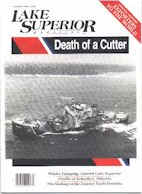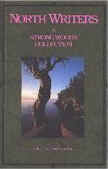

FROM LAKE SUPERIOR MAGAZINE / FEBRUARY-MARCH 1990
Republished, North Writers: A Strong Woods Collection, Ed. by John Henricksson
(Univ. of Minn. Press, 1991).
SNOWCAMP
ROMANCING WINTER IN THE
LAKE
SUPERIOR WILDERNESS
Written and Photographed
by Mark Sakry
Fifty degrees below zero was to him just precisely fifty degrees
below zero. That there should be anything more to it than that was a thought that
never entered his head. … The trouble with him was that he was
without imagination.
—From "To Build a Fire" by Jack London
To know winter in the wilderness is to know silence. When all
is still—when the
Arctic storm has dwindled to a sighing memory and the forested lakes stretch unbroken
before you with a fresh cover of new-fallen snow—the silence is overwhelming.
You cannot really hear it, as some say you can. Yet, for a time, a certain loudness
rings.
Then, listen closely, beyond the silence, and you begin to hear faint
voices. Hushed whisperings seem to emanate from nowhere and everywhere at once, as
though from some in-between world, somewhere between death and rebirth—the sleeping
billions: multitudes entombed by ice and snow and infinitesimal cold speaking
through the immense silence. Perhaps of an afterlife. Perhaps of the promise
of distant spring.
And just when you think
you are beginning to understand, a breeze breathes through the trees. The whispers
vanish. Snow hisses softly down through the pines as their peaks rock gently against
the sky, then the gravelly grawk-grawk of a raven on the far shore. A
muffled groan rises from the lake as the ice yields to the sudden, gentle tug from
above. Somewhere, a pop from a fire and the murmur of voices inside the forest.
This is the setting,
the magic. This is what compels a handful of adventuresome souls every winter to
venture off established trails into the frozen wilderness of the Lake Superior region.
Some ski, some snowshoe. Many go just for the day, realizing they
must return before night casts its mortal shadows across the forest. As many see it,
to be caught in the dark would be folly. The moon, if it's full enough, might defer
risk for awhile. But it rests on one's best reckoning to quit the fading forest or
be forced on humankind's most ancient and incumbent measure for surviving the winter
night—to build a fire.
Yet some see it differently. Just a few. Those with the
wherewithal. And an incredible amount of imagination.
The Inuit had many names for it: pukak, upsik, anniu. To
the rest of us, it's all the same stuff: Snow.
To sleep under it, to repose in sublime comfort among heartfelt
comrades inside a hollowed-out mound, while the wind howls outside on one of the coldest
nights of the year, is indescribable. To the winter adventurer, it is the height of
romance, the consummation of his or her wilderness ability.
Indeed, it is not just imagination but ability which makes accessible
some of the most enchanting haunts of the Lake Superior region and fully opens the door to
the winter season.
Once one attains the essential skills with which to comfortably endure
extended stays in the winter wilderness, larger-scale excursions are possible (not unlike
their summer canoe-trip counterparts) into such areas as the Boundary Waters Canoe Area
Wilderness of Minnesota and Quetico Provincial Park of Ontario. Here the combination
of scenic forests and flat lake travel affords immeasurable beauty over long distances.
For shorter, though possibly more strenuous, wilderness excursions,
Porcupine Mountains Wilderness State Park in Michigan and Cascade River State Park in
Minnesota offer miles of rolling forest in pristine alpine settings. Many state and
provincial parks in the Lake Superior region offer groomed trails as well as winter
camping. All, by virtue of the season itself, afford almost total seclusion and
unadulterated winter beauty.
This also applies to other remote areas where, with the exception of
snowmobiles, accessibility by mechanized travel is limited during winter months. For
instance, winter wayfarers will find suitable conditions for a wilderness snowcamp in many
places beyond the road heads of Superior, Chequamegon, Hiawatha and Ottawa National
forests.
Nothing compares with the special confidence gained by facing the
winter elements in a snowcamp for an extended stay in the Lake Superior wilderness. Nor the beauty. But the
essential skills—knowing not only how to "survive," but (more
importantly) how to be comfortable—are necessary before winter becomes less formidable than
it was. If there is a single key to staying comfortable, even in the kind of cold which
grips the northern Great Lakes region, it is doing away completely with the notion
that one must rely on an external heat source, such as a stove or campfire. Winter campers
depend on internal heat for warmth.
The body is viewed as a furnace fueled by
high-calorie foods. These are rarely taken in the form of sugar; they are eaten (in
seemingly gluttonous quantities) in the form of fat, protein and complex carbohydrates,
like nuts and whole-grain cereals, which burn more slowly and substantially. The
furnace is then insulated properly—no cotton, please—in layers of clothing which
may be added or removed to suit the level of activity. This prevents overheating and
excess perspiration which can dampen clothing (especially cotton), ultimately causing heat
to be lost faster than the body can generate it. The condition is known as
hypothermia.
Plenty of fluids (more than you need) are routinely consumed to prevent
dehydration common to winter activity. Body fluids must be maintained to properly
metabolize food-fuel into heat. But no alcohol; this promotes heat loss.
Coffee is avoided because it is diuretic; it depletes body fluids.
Water is obtained by melting snow or boring through lake ice with an
auger and dipping it out. While many areas in the Lake Superior region provide pure
natural water, it is still good practice to boil water before consuming it.
To be truthful, overnight shelter, even in an established snowcamp, is
unnecessary. That is, if you have an adequate sleeping system consisting of a fully rated
winter sleeping bag or combination three-season bag and liner, with a closed-cel foam pad
between your bag and the ground. Otherwise, a quin-zhee (pronounced
kwahn-chee) snow shelter, fashioned by hollowing out a mound of snow, will keep you
surprisingly warm, even in a three-season bag, if the shelter is built with its floor
elevated above the top of a small door opening. A tent will keep the wind and snow
off, as well as help consolidate your sleeping area, but it won't insulate you from
outside temperatures.
The pack sled, or pulk, has rendered the backpack nearly obsolete for
winter travel, especially over flat lake country. It is not only easier to tote, it
extends the amount of camp hardware and equipment you are able to bring along (about the
same as a summer canoe trip). With a harness you can put your dog to work, too.
February is a good time to plan an extended trek. Average daytime
high temperatures around the Lake Superior region are around 20 degrees above zero.
But don't be caught off guard. It can still hit sub-zero; best to be prepared for
the worst. Plan all winter treks as though you were going in mid-January.
And if you've never spent an entire night outdoors in winter before,
try it in your back yard first. It's your safest testing ground.
Wilderness was once defined as that area of undisturbed natural land
resting beyond the road head. Truly, by that definition, winter brings to this
region, already rich and abundant with wild land, a wilderness of immense proportion.
Indeed, the stillness invoked by Nature's hand upon the vast forested areas about
Lake Superior amplifies the implicit solitude and romance of the region.
It is accessible to anyone with a pair of skis, or snowshoes, and the
wherewithal to negotiate even a half-day trek beyond the trail head. But with a
little more imagination, you may be compelled to advance your sensibilities beyond the
perimeters of daylight into the unvisited realm—of the sleeping billions.
It waits. Still. Silent. Snowcamp. LSM
Mark Sakry, a resident of Brimson,
Minnesota, has written for Minnesota Out-of-Doors, Boundary Waters Journal and the Duluth
News-Tribune.
FURTHER INFORMATION
In addition to certain private lands, the
national, state and provincial parks and forests provide day use and limited overnight
camping opportunities. Be sure to register with park representatives prior to
starting your trip into an area and for exact information. They have literature
available.
Michigan
Michigan Tourism 800-5432-YES
Michigan Upper Peninsula Travel & Recreation Association 906-774-5480
Ottawa National Forest (Ironwood) 906-9324330
Hiawatha National Forest (Escanaba) 906-786-4062
Porcupine Mountain State Park 906-885-5275
Minnesota
Minnesota Tourism
Nationally 800-657-4700
In Minnesota 800-552-9747
Voyageurs National Park
(International Falls) 218-283-9821
Superior National Forest (Districts)
Laurentian (Aurora) 218-229-3371
Gunflint (Grand Marais) 218-387-4750
Isabella (Isabella) 218-323-7722
Kawishiwi (Ely) 218-365-6185
La Croix (Cook) 218-666-5251
Tofte (Tofte) 218-663-7981
Chippewa National Forest (Cass Lake) 218-335-2226
Ontario
Ontario Tourism 800-ONTARIO
Pukaskwa National Park (Huron Bay) 807-229-0801
Provincial Parks (Day Use Only)
Kakabeka Falls (Thunder Bay) 807-577-4231
Sibley (Pass Lake) 807-933-4332
Wisconsin
Wisconsin Tourism 800-372-2737
Apostle Islands National Lakeshore (Wahsburn) 715-779-3397
Chequameon National Forest (Park Falls) 715-762-2461
Nicholet National Forest (Rhinelander) 715-362-3415
State Parks
Pattison State Park 715-399-8073
Copper Falls State Park 715-274-5123
LAKE SUPERIOR MAGAZINE / FEBRUARY-MARCH 1990
Copyright C. Mark Sakry 1988
Article Photos and Captions
RELATED TOPICS:
The Quin-Zhee Shelter
Building a Quin-Zhee in the BWCAW
An Early Winter Journey
Get Ready to Camp in Winter
Cold-Weather Deer Quiz



